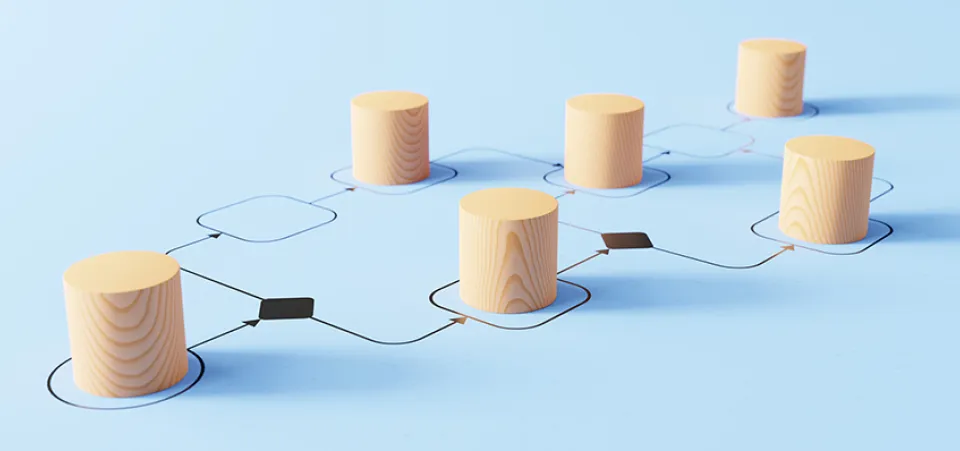

Posted in Drupal, Software & Development
July 24, 2024
START SMALL, SCALE BIG
Where to Start: Common Ways to Stage a B2B Transformation
Transforming your company's digital presence is essential in today's B2B landscape to meet the expectations of tech-savvy buyers who prefer self-service options. Without these choices, customer dissatisfaction and loss of market share are sure to follow. But, taking on a large-scale overhaul of your operations is a monumental task. This article will show how starting small may be your best course of action when tackling ecommerce change in B2B.
B2B transformation is a daunting term for many businesses looking to move online. However, the competitive landscape is changing, with more and more companies investing in their technologies to accommodate a changing buyer demographic.
Choosing the Right Path for B2B Digital Transformation
There is no one “right” way to start your digital transformation; it is only the right way for your business. A path often emerges by carefully examining the overarching business objectives and variables. But what are those variables?
Products or Services
- Do you have complex products or services?
- Do you sell in large quantities?
- Where do you ship your products?
- Do your products or services have dependencies?
Customers
- Where are your customers?
- Who at your customer's company is doing the buying?
- How are they buying? PO? Invoice? CC?
- Where are they doing their research?
Processes
- How many steps in the current process are manual?
- Where is all the data currently kept?
- Who is operating and overseeing the process?
- How does the selling process affect other departments?
- Elimination of what process will have the biggest ROI?
That’s just a small snapshot of variables to consider when starting your B2B digital transformation. As 73% of 20—to 35-year-olds are now involved in purchasing decisions, understanding HOW your customer buys is critical in choosing the right path forward.
However, this is often placed on one person to drive this forward for B2B and Manufacturing companies, which adds to the challenge. There is usually a lack of expertise in the various areas of a digital experience platform and a fear of “upsetting the apple cart” or, in other words, disrupting existing distribution channels.
Those fears and challenges are valid, so we at Acro Commerce often recommend an iterative, phased approach to ecommerce. Much like the detail in another Acro Commerce article titled, Leveraging SaaS as an Entry-Point to Complex Ecommerce, often dipping a toe is a great way to start.
Not Digitizing Operations Means Losing Market Share and Talent
“As baby boomers retire and millennials mature into key decision-making positions, a digital-first buying posture will become the norm,” said Cristina Gomez, managing vice president for the Gartner Sales Practice. “As customers increasingly learn and buy digitally, sales reps become just one of many possible sales channels. Because of this, sales organizations must be able to sell to customers everywhere the customer expects to engage, interact and transact with suppliers.” - Gartner, from The New B2B Digital Customer Experience.
As more B2B businesses move online and a younger demographic enters the decision-making process, companies that do not adopt an online model will find it increasingly challenging to keep up with competitors.
It won’t just be in the market, either. Companies that don't innovate will lose talent who are frustrated with inefficient workflows and have to learn complex or manual processes just to accomplish things that could be automated.
However, a phased approach like the one we recommend below gives companies time to do it right, as we are often brought in to “rescue” projects.
Starting Small: Dipping a Toe in First
What does “dipping a toe” mean?
It means identifying a minimum viable product with your stakeholders that satisfies a key business objective without disrupting your existing network.
A minimum viable product (MVP) is a version of a product with just enough features to be usable by early customers, who can then provide feedback for future product development. - Wikipedia
This could involve launching on a SaaS platform like Shopify or BigCommerce with a limited product offering or implementing an ERP system, such as Acumatica, to start the automation journey of your backend systems.
By selecting one existing process that creates friction (friction being a manual process, lost data, lost sales) and implementing a technical solution to fix it, you’re well on your way to a complete digital transformation. You won't want to stop once you see the impact of automation and how you can leverage technology to meet your specific needs.
At Acro Commerce, we work with you to understand the complexities of your business and help you identify those areas of friction where digital transformation can generate the greatest value for your business. If you want to learn more about this process, check out our article on Discovery and Strategy.
